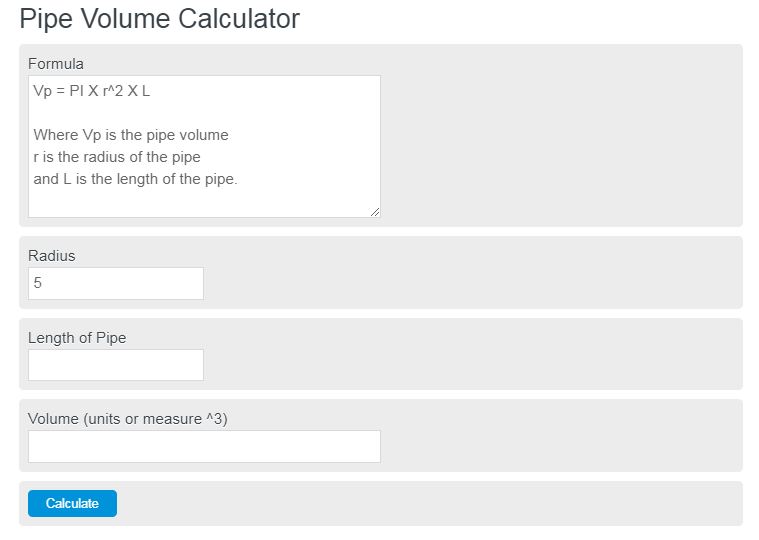Enter the inner diameter and the length of any pipe to calculate the total volume of that pipe. This is useful in many fluid applications and engineering.
- Pipe Flow Calculator
- Reynolds Number Calculator
- Hoop Stress Calculator
- GPM to Pipe Size Calculator
- Pipe Pressure Rating Calculator
- Surface Area of a Pipe Calculator
- Plate Thickness Calculator
- Pipe Ovality Calculator
Pipe Volume Formula
The volume of a pipe can be calculated with the following formula:
Vp = PI * r^2 * L
- Where Vp is the pipe volume
- r is the radius of the pipe
- and L is the length of the pipe.
To calculate the pipe volume multiply the radius squared by pi times the length.
Pipe Volume Definiton
A pipe volume is defined as the total enclosed volume inside the length of a pipe.
How to calculate the volume of a pipe
The following example is a step-by-step guide on how to calculate the volume of a pipe.
- The first step is to analyze the equation presented above to determine what variables are needed in order to solve the problem. As you can see above, both the radius and the length of the piper must be known to calculate the volume. Note that the radius is the inside radius of the piper.
- The next step is to measure or calculated the radius. For this example, we will assume the inner diameter is given as 4m. To calculate the radius simply divide by 2 to get 2m.
- Now, the length of the pipe must be determined. Using a measuring tape or caliper, you find that the length of the tube is 10 meters.
- Finally, enter the information found above into the equation to find the volume of the pipe. Vp = pi * 2*2*10 = 125.66 m^3
FAQ
Why is calculating the volume of a pipe important in fluid applications and engineering?
Calculating the volume of a pipe is crucial in fluid applications and engineering because it helps in determining the capacity of fluid the pipe can carry. This information is essential for designing efficient piping systems, ensuring adequate flow rates, and preventing overflows or underflows in various applications such as water supply, irrigation, and chemical processing.
How does the inner diameter of a pipe affect its volume?
The inner diameter of a pipe directly influences its volume because the volume is calculated based on the radius (which is half of the inner diameter) squared, multiplied by pi and the length of the pipe. A larger inner diameter means a larger radius, leading to a higher volume, assuming the length of the pipe remains constant. This relationship is crucial for selecting the right pipe size for specific flow requirements.
Can the pipe volume formula be used for pipes of any shape?
The pipe volume formula provided (Vp = PI * r^2 * L) is specifically designed for cylindrical pipes, where the cross-section is a circle. For pipes or ducts with different shapes (e.g., square, rectangular), other formulas that account for the unique cross-sectional area are needed. However, for any cylindrical pipe, regardless of its size, this formula is applicable and provides a straightforward way to calculate its volume.

